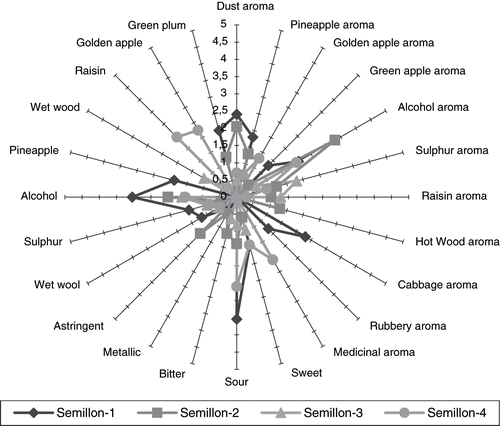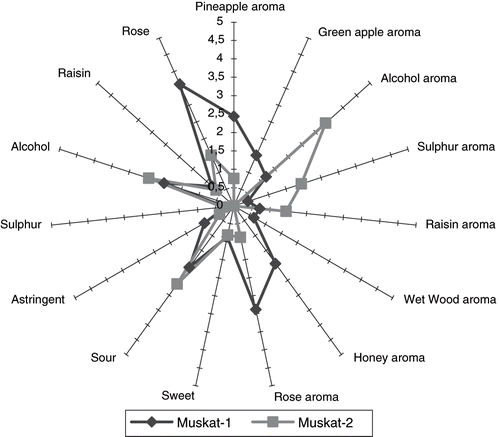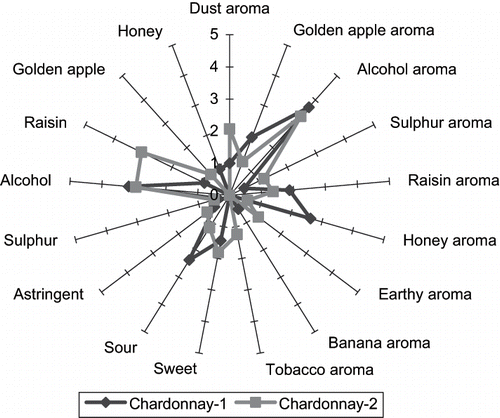Abstract
The aim of the present study was to determine the effect of using different grape varieties on the sensory flavor characteristics of Turkish white wines. 17 commercial white wines from 5 grape varieties (Emir-5, Narince-4, Semillon-4, Muscat-2, Chardonnay-2) of 2001 vintage, obtained from local market were analyzed by quantitative descriptive analysis. Graphical representation of the sensory profiles including aroma and flavor characteristics were provided as spider-web diagrams by plotting the mean values for the sensory descriptors. Least significant differences between wines for each descriptor were calculated by analysis of variance (ANOVA) using the SPSS program. It was observed that characteristics such as alcohol, sulphur, and raisin were present in the aroma and flavor of all wine varieties, while some characters seemed to be specific for wines produced from certain types of grapes (grape juice- Emir-1, 2, 3, 4; rose-Muscat-1,2; green plum-Semillon-1, 2; melon-Narince-3; banana- Chardonnay-1; tobacco- Chardonnay-2).
INTRODUCTION
Wine flavor is formed by complex interactions of the volatile and nonvolatile compounds created as a result of the ripening of the grape and of winemaking process.[Citation1,Citation2] White wines involve several compounds which contribute to the unique flavor and several studies were conducted by descriptive analysis for determining the flavor of white wines. In some of these studies, the effect of fermentation with oak chips were investigated,[Citation3] while in other studies the effect of storage on flavor was studied.[Citation4] The impact of different grape varieties,[Citation5,Citation6] and the effect of geographic origin[Citation7,Citation8] on wine quality, and the effect of different sweetening treatments were also demonstrated in different researches. In a study conducted by Wilker et al.,[Citation9] three sweetening treatments—juice addition, muté addition (one vintage), and stopped fermentation were examined for their impact on the aroma and the chemical compositions were also compared. In a study conducted by Fischer et al.[Citation10] the impact of geographic origin, vintage and wine estate on sensory properties of commercial Riesling wines were investigated. The study has shown that wines differ substantially regarding to their flavor within the same wine yard designation.
Three white wine varieties cultivated in Canary islands were studied and profiled by descriptive analysis.[Citation6] It was observed that all descriptors except astringency differed significantly among the wine varieties. In a study conducted by Mirarefi et al.,[Citation11] the sensory profiling of Chardonel wines were studied by descriptive analysis and a Chardonel wine sensory attribute wheel was created using all the descriptors generated by the panel. Sivertsen et al.[Citation12] used sensory descriptive analysis, to distinguish, Botrytis wines from non-Botrytis wines as determined by immunoassay. Despite the high variability in grape variety, wine processes, and wine regions of the wines selected for this study, there was a trend showing that wines with low Botrytis antigen units were high in fresh fruit and citrus aromas. However, wines with high Botrytis antigen levels were not especially high in perceived honey aromas. The flavor characteristics of some organic wines produced from 6 different grape varieties (Merlot, Grenache, Carignan, Cabernet sauvignon, Semillon, Columbard) by using descriptive flavor profile analysis were determined in a study conducted by Yıldırım et al.[Citation13] In another study conducted by Yıldırım et al.[Citation14] a total of 15 red wines produced from 4 international grape varieties cultivated in Turkey and from 4 native Turkish grape varieties were evaluated and profiled by quantitative descriptive analysis.
The aim of the present study was to determine the effect of using different grape varieties on sensory flavor characteristics of white wines. For this purpose, commercial wines from 5 different grape varieties (Emir, Semillon, Narince, Muskat, Chardonnay) cultivated in Turkey were profiled by quantitative descriptive analysis. Emir and Narince grape varieties are native to Turkey, and there aren't any studies in the literature related to the flavor characteristics of these wines.
MATERIALS AND METHODS
Wine Samples
Seventeen commercial white wines from 5 grape varieties (Emir-5 samples, Narince-4 samples, Semillon-4 samples, Muskat-2 samples, Chardonnay-2 samples) of 2001 vintage were obtained from local market in Izmir, Turkey, and the samples were stored in dark rooms at 12 ± 2°C prior to analysis.
Descriptive Sensory Analysis
The tests were conducted in an air conditioned sensory test laboratory equiped with individual booths. Panelists sensitivity to major tastes and odors were tested according to ISO-3972:1991.[Citation15] Wines (30 ml) were served at room temperature (20–23°C), in 170 mL-tulip-shaped glasses coded by using randomly selected 3-digit numbers, and evaluated by 5 trained judges. Repeatability of the judges were evaluated by giving the same wine sample 5 times and measuring the standard deviation of their results. Wine samples were analyzed by quantitative descriptive analysis as suggested in ISO.[Citation16] Seven one-hour training sessions were conducted prior to the formal evaluation of wines. During the first two training sessions, descriptive terms for the taste, aroma, and flavor attributes that will be used in evaluation of wines were generated by sniffing to evaluate the aroma and then tasting and swallowing the samples for retronasal evaluation of flavors. In the following sessions, the panel was provided with the reference standards, the judges identified and rated the intensity of each character on a 50 mm unstructured scale. The results from the evaluations were converted into numbers by measuring the distance in centimeters from the left end of the scale to the marked intensity. The series of descriptors and references used for describing white wine aroma and flavor are shown on . Ten formal sessions were held to evaluate the seventeen wines in duplicate. Formal evaluation of wines was performed by consensus-based discussions.
Table 1 Descriptive vocabulary for white wines
Data Analysis
Graphical representation of the sensory profiles including aroma, taste and flavor characteristics were provided as spider-web diagrams by plotting the mean values for the sensory descriptors. Least significant differences between wine means for each descriptor were calculated by analysis of variance (ANOVA) using the SPSS program and the results were evaluated at 95% confidence level.[Citation17]
RESULTS AND DISCUSSION
Aroma and flavor sensory characters of wine samples with mean intensity scores are given in and . Emir is a native grape variety grown in Nevşehir region of Turkey which gives good quality white wines.[Citation18] The flavor profile diagrams of 5 wines from Emir grape variety are shown on . It can be observed from the figure that alcohol and sulphur aroma attributes and sweet, sour, wet wool, and alcohol flavor attributes were detected in all Emir wines, whereas dust, green apple, raisin and grape juice aroma notes and salt, metallic, sulphur, medicinal, and raisin flavor characters were detected in majority of the samples. Pineapple aroma and flavor were found to be statistically significant (p < 0.05) for Emir-3 and 4 wines, while golden apple aroma and flavor were significant (p < 0.05) for Emir-3 wine. Green apple aroma and flavor were present in Emir-2 and Emir-5 wines (p < 0.05). Narince is a native grape variety grown in central Anatolia and especially in the Tokat region of Turkey.[Citation19] The flavor profile diagram showing the different characters of 4 wines from Narince grape variety are given on .
Table 2 Aroma sensory characters of wine samples with mean intensity scores
Table 3 Flavor sensory characters of wine samples with mean intensity scores
It can be observed from the figure that alcohol and sulphur aroma notes and sour and wet wool flavor attributes were detected in all Narince wines, whereas dust and honey aroma characters and sulphur, alcohol, medicinal, raisin and unripe grape flavor attributes were detected in majority of the samples. Pineapple aroma and melon flavor were significant (p < 0.05) for Narince-3, whereas green apple aroma and flavor were found to be significant (p < 0.05) for Narince-2.
Semillon grape variety is widely grown in Bordeaux region of France in Australia and California. The flavor of Semillon wine is described as grassy, figgy, nutty and floral depending on the climate. In France, Australia and increasingly in California it is often blended with Sauvignon Blanc to cut some of the strong “gooseberry” flavor of the latter grape.[Citation20] The flavor profile diagrams of 4 wines from Semillon grape variety grown in Turkey are shown on . It can be observed from the that dust and alcohol aroma and sweet, sour, alcohol, and sulphur flavor attributes were detected in all Semillon wines, whereas pineapple, sulphur and raisin aroma attributes and wet wool flavor attributes were detected in majority of Semillon wines. Pineapple aroma was detected in Semillon-1, 2, 4 while pineapple flavor was present only in Semillon-1. Semillon-1 and 2 involved green plum flavor (p < 0.05). Golden apple aroma and flavor attributes were found to be significant (p < 0.05) for Semillon-4 wine. Muscat grape is an aromatic variety, which produces fruity and softly perfumed wines.[Citation19] The flavor profile diagram showing the different characters of 2 wines from Muscat grape variety are given on . As seen from , pineapple, alcohol, sulphur, raisin, and rose aroma attributes and sweet, sour, astringent, sulphur, alcohol, raisin, and rose flavor notes were detected in all Muscat wines. Muscat-1 involved green apple, wet wood, and honey aroma attributes (p < 0.05).
Chardonnay is one of the world's most well known and noble white grape variety that produces medium to full-bodied white wines. Apple and green apple aromas are classic for the flavor of Chardonnay wine although tropical fruit, pineapple, melon, and honey flavors can be present.[Citation19] The flavor profile diagrams of 2 wines from Chardonnay grape variety are shown on . It can be observed from the figure that dust, golden apple, alcohol, sulphur, raisin and honey aroma notes and sweet, sour, astringent, alcohol, sulphur, and raisin flavor attributes were detected in all Chardonnay wines. Banana aroma and honey flavor were significant (p < 0.05) for Chardonnay-1. Chardonnay-2 involved earthy and tobacco aroma and golden apple flavor (p < 0.05).
CONCLUSION
Turkish white wines examined in this study were found be rich in aroma and flavor attributes involving mostly sweet, sour and fruity notes. It was observed that characteristics such as alcohol, sulphur and raisin were present in the aroma and flavor of all wine varieties, while some characteristics seemed to be specific for wines produced from certain types of grapes (grape juice- Emir-1, 2, 3, 4; oleaster flower- Emir- 4; rose-Muscat-1,2; green plum-Semillon-1, 2; melon-Narince-3; banana-Chardonnay-1; tobacco-Chardonnay-2). Emir and Narince wines which are native grape varieties grown in central Anatolia were analyzed by descriptive analysis in the present research. Thus the results obtained from this study can be the basis of other studies which can be conducted on the sensory quality of Turkish white wines. Further studies investigating the effect of different grape growing, harvesting, transporting, wine making, and aging techniques on the flavor of white wines produced from different cultivars in Turkey are also recommended.
ACKNOWLEDGMENTS
The authors wish to give thanks to Ege University Science and Technology Centre for financial support and to Sevilen, Doluca, Yazgan, Melen, and Pamukkale wineries for supplying the wine samples.
REFERENCES
- Arozarena , I. , Casp , A. , Remedios , M. and Navarro , M. 2000 . Multivariate Differentiation of Spanish Red Wines According to Region and Variety . Journal of Science of Food Agriculture , 80 : 1909 – 1917 .
- Thorngate , J.H. 1997 . The Physiology of Human Sensory Response to Wine: A review . American Journal of Enology and Viticulture , 48 : 271 – 279 .
- Perez-Coello , M.S. , Gonzales-Vinas , M.A. , Garcia-Romero , E. , Cabezudo , M.D. and Sanz , J. 2000 . Chemical and Sensory Changes in White Wines Fermented in the Presence of Oak Chips . International Journal of Food Science and Tecnology , 35 : 23 – 32 .
- Presa-Owens , C.D.L. and Noble , A.C. 1997 . Effect of Storage at Elevated Temperatures on Aroma of Chardonnay Wines . American Journal of Enology and Viticulture , 48 : 310 – 316 .
- Heymann , H. and Noble , A.C. 1989 . Comparison of Canonical Variate and Principal Component Analyses of Wine Descriptive Analysis Data . Journal of Food Science , 54 : 1355 – 1359 .
- Gutierrez Afonso , V.L. , Darias , J. , Ars , R. , Rosa , Medina , Eugenio , M. and Diaz , M. 1998 . Descriptive Analysis of Three White Wine Varieties Cultivated in the Canary Islands . American Journal of Enology and Viticulture , 49 : 440 – 444 .
- Douglas , D. , Cliff , M.A. and Reynolds , A.G. 2001 . Canadian Terroir: Characterization of Riesling Wines from the Niagara Peninsula . Food Research International , 34 : 559 – 563 .
- Schlosser , J. , Reynolds , A.G. , King , M. and Cliff , M. 2005 . Canadian Terroir: Sensory Characterization of Chardonnay in Niagara Peninsula . Food Research International , 38 : 11 – 18 .
- Wilker , K.L. , Dharmadhikari , M.R. and Goin , J.C. 2004 . Effect of Sweetening Treatments on White Wine Aroma and Composition . American Journal of Enology and Viticulture , 55 ( 2 ) : 168 – 173 .
- Fischer , U. , Roth , D. and Christmann , M. 1999 . The Impact of Geographical Origin, Vintage and Wine Estate on Sensory Properties of Vitis vinifera cv. Riesling wines . Food Quality and Preference , 10 : 281 – 288 .
- Mirarefi , S. , Menke , S.D. and Lee , S.Y. 2004 . Sensory Profiling of Chardonel Wine by Descriptive Analysis . Journal of Food Science , 69 : 211 – 217 .
- Sivertsen , H.K. , Dewey , F.M. and Heymann , H. 2005 . Relationship between Sensory Descriptive Analysis and Levels of “Botrytis” Antigens in Dessert Wines . American Journal of Enology and Viticulture , 56 ( 4 ) : 330 – 335 .
- Yıldırım , H.K. , Yucel , U. , Elmacı , Y. , Ova , G. and Altuğ , T. 2005 . Interpretation of Organic Wine's Flavor Profile by Multivariate Statistical Analysis . Acta Alimetaria , 34 : 317 – 330 .
- Yıldırım , H.K. , Elmacı , Y. , Ova , G. and Altuğ , T. 2007 . Descriptive Analysis of Red Wines from different grape cultivars in Turkey . International Journal of Food Properties , 10 : 93 – 102 .
- International Standards Organization . ISO 3972: Sensory Analysis-Methodology-Method of Investigating Sensitivity of Taste . 1991 . 7.
- International Standards Organization . Sensory Analysis-Methodology—Initiation and Training of Assessors in the Detection and Recognition of Odours . ISO 5496 . 1992 .
- Mead , R. 1988 . The Design of Experiments , 620 New York : Cambridge University Press .
- Nurgel , C. , Erten , H. , Canbaş , A. , Cabaroğlu , T. and Selli , S. 2002 . Influence of Saccharomyces Cerevisiae Strains on Fermentation and Flavor Compounds of White Wines Made from cv. Emir Grown in Central Anatolia, Turkey . Journal of Industrial Microbiology and Biotechnology , 29 : 28 – 33 .
- Aktan , N. and Kalkan , H. 2000 . Şarap teknolojisi, Kavaklıdere Eğitim Yayınları 615 Ankara
- Anon. 2005. www.winelovers.com/wineguest/wgg.html (Accessed: 20 December 2005 ).




